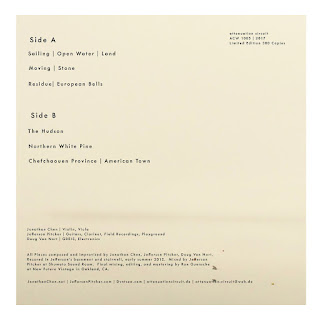Albion's Eco-eerie by Phil Smith
Phil Smith has always been publishing very interesting books and studies, which are related to site-specific studies, mythogeography, psychogeography and anything that revolves around topics of hauntologic nature.
His new book ‘’Albion Eco-Eerie. TV and Movies of the Haunted Generations’’ published by Temporal Boundary Press opens the reader to very distinct and complex landscape of ecology and politics that dwell within the boundaries of the movies and tv shows such as: Night of the Demon, The Maze, The Company of Wolves, The Quatermass Xperiment, Quatermass 2, The Strange World of Planet X, Fireball XL5: 'Plant Man from Space', Quatermass and the Pit, O Lucky Man!, The Changes, Children of the Stones, Whistle and I'll Come to You, A Warning to the Curious, The Lovecraft Investigations (podcast), Hellraiser and Hellbound: Hellraiser II, The Girl with All the Gifts.
It is quite brave of a person with an academic profile to address the themes of traumas, political and ecological conflicts and crisis and see the tropes, traits of them in the items related to popular culture and especially.
In its own way, and pointing out themes and messages that can be read through the narratives of the aforementioned examples of movies and tv shows, Prof. Smith categorises and creates his own, unique systematics of Demons. First two chapters are divided between The Material Demons and The Vegetable Demons.
Material Demons start with the reference to Heinrich Heine who was probably the first in the mainstream culture – in his case early nineteenth century Romantic period – to point out how ‘’nature spirits’’ have been renamed and redefined as evil demons by Christianity.
This is the starting point of the analysis and observations that the author introduces – the notion that the movie and tv gothic edgelands can completely change the way our cultural training on what spirits, demons and anything in that aspect of cryptozoological systematics possess.
The analysis of the environment and the ecosystems where all those beings dwell is intricate and not only depicts the plots, characteristics but also describes how this all inhabits our subconscious terrain. The maze of symbols and traps of understanding and misunderstanding on different levels is dense and interesting enough – through references to modern day reality which was divided by pandemic, political differences and animosities and many other cross-culture boundaries.
The next chapter – The Eco-Eerie Margins of Albion move on to the topics of post-colonial landscape of Albion. Smith puts forward the example of ‘’O Lucky Man!’’, ‘’The Changes’’, ‘’Children of the Stones’’- The mythical aspects of reality, archetypical nomadic requirements of the body, romantic vs un-romantic, nature – whether it is touched by something enchanted, technological interference.
This analysis comes to a very important point – the division between enchantment and possession. In the whole landscape of weirdness and the programmes of eco-eerie and please remember it is set in the post-war period.
The last chapter – Matter Questing has themes of Prometheian nature. How is the matter created in terms of ambivalence and abstract questions of human identity and its pursuits?
Rather small in volume but packed with so much research material that it’s a must to re-read it and use it as a key reference, ‘’Albion eco-eerie’’ is a truly valuable read for all of those who look at some different details of what’s beyond the known meta-reality.
https://www.plymouth.ac.uk/staff/phil-smith
https://temporalboundary.bigcartel.com/product/albion-s-eco-eerie-by-phil-smith

Comments
Post a Comment